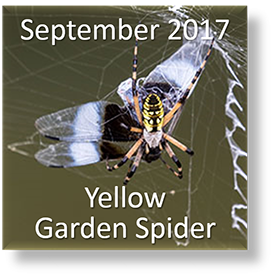 yellow garden spider Argiope aurantia
yellow garden spider Argiope aurantia
What Does It Look Like?
Spiders have an external skeleton and jointed legs as do all animals classified as arthropods. Like all spiders, the yellow garden spider has eight legs, no antennae, no wings and two body segments: the cephalothorax and abdomen. The cephalothorax is the first body segment. The legs and eyes are attached to it. This species has eight eyes.
Male and female yellow garden spiders have different appearances. The female is much larger than the male. Her front legs are usually entirely black. Her second, third and fourth pairs of legs are yellow or red close to the body and black farther out. Her abdomen is an elongated oval that is pointed toward the rear, notched in front and patterned yellow and black with two anterior humps. There is a black stripe on the top of the abdomen. Her cephalothorax has silvery hairs and yellow coloration. The underside of the abdomen has a central, black band with yellow spots. There is a long, yellow or white stripe on each side of the black band.
The cephalothorax of the male yellow garden spider is brown with white hairs. The top of his abdomen has an orange-brown central band bordered by white bands. His legs are lighter in color than those of the female and are solid brown.
Immature yellow garden spiders have banded legs.
How Big is It?
The body of a mature female yellow garden spider measures from about three-fourths to a little more than one inch in length. The male’s body is close to one-fourth inch long.
Where Does It Live?
The yellow garden spider lives statewide in gardens, tall grasses, shrubs and other open areas with plentiful sunlight.
How Does It Reproduce?
Mature females can be seen from August through September. Males mature a week or two earlier than females. This species reproduces twice per year. The male builds a small web near or in the female’s web. He courts her by plucking on the strands of her web. If she is interested in mating, he transfers sperm to her using his pedipalps. The pedipalp is a small structure that looks similar to a leg on each side of the body between the jaws and the first leg. The end of each pedipalp is swollen in males. Before courting, he places a drop of sperm on a special web for each pedipalp then draws it into the pedipalp. During mating he inserts the pedipalp into a special opening on the underside of the female’s abdomen and releases the sperm. After the transfer from both pedipalps is complete, the male dies. The female produces egg sacs at night. She lays the eggs on a sheet of silk then covers them with a different type of silk. Using her legs, she rolls the sheets into a sphere shape with a neck. Each papery sac is from about one-half inch to one inch in diameter. She produces from one to four egg sacs, each containing about one thousand eggs. She hangs the sacs on her web or on plants near the web. She guards the sacs as long as she can before she dies in the fall. The very tiny spiderlings emerge from the cocoon in April or May.
What Does It Eat?
The yellow garden spider eats large, flying insects like grasshoppers, moths and honey bees, that become trapped in its web. The female tends to eat the center of the web each night then replaces it the next morning. It is believed that the web strands she eats contain tiny insects and other organisms that provide her with nutrients.
Does Anything Eat It?
Wasps, other yellow garden spiders, birds, lizards and small mammals are all predators of yellow garden spiders.

